What are myths and superstitions? Do they have any element of truth to themselves, or are they just inventions on the part of elders to scare children into completing their meals? For example, every time I fidgeted and fiddled with my food, my mother frightened me with stories of a scary spirit that would come and make a mustache sprout in my face if I did not finish my meals (which is the inner kid in me ). still believe). Regardless, the folly of childhood aside, myths are strongly intertwined in the daily life of any society. Be it religion, folk tales, ancestors or historical stories, which society has at least a few activities or rituals centered on the spirits that haunt these myths?
Sri Lankan myths, demons and ritualistic dances
Sinhalese believe in the existence of two types of demons - one who has almost the same status as gods and deities and is believed to bring good to the people, and one who is cruel and believed to torture people with diseases and rejoice in their misery.
In Sri Lankan culture, demons are known by Sinhalese names such as yakseya and yakka. According to legend, they are ruled by a demon king known as Wesamuni, who rules over the demons with an iron fist. Wesamuni forbade his henchmen to kill people. Any deviation from his teachings can be punished with boiling, frying, impaling or death. Legend has it that the king had a sword like Thor's hammer - a golden magic sword that flies out of his hand, beheads thousands and goes back to his hand. But in order not to be completely denied for being mischievous, demons therefore bring various diseases upon humans, and that is why many communities in rural areas choose to cure diseases through exorcism rituals.
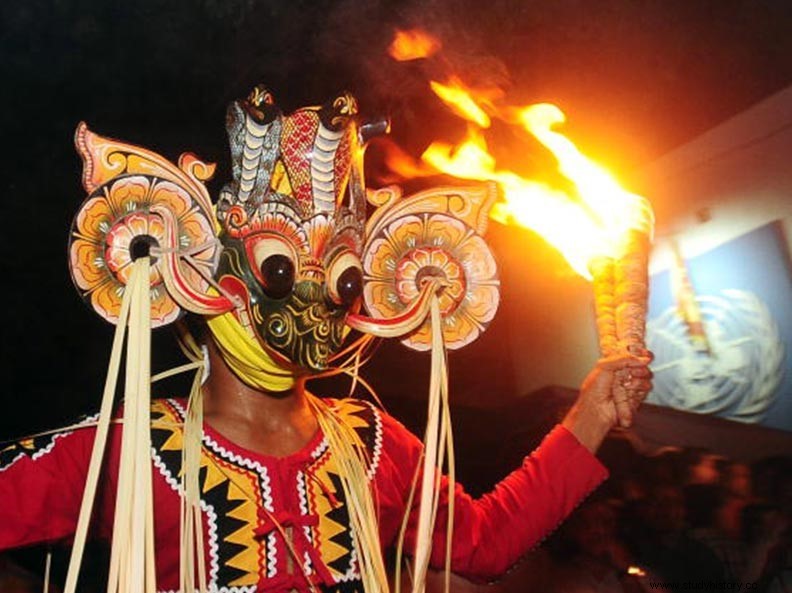
These rituals consist of various dances and activities that engage in curing any person who has cycled with illness, accident or dementia, believed to be caused by an evil spirit. The dancers are almost always members of the lower caste societies. During the ritual, the sick person lies next to them while many shrines made of palm leaves surround their house, each of which is dedicated to specific demons to lure them into the ritual arena. The role of the demon king, Vesamuni, is played by the main exorcist. The dancers are all men. They wear a red cloth with fringes made of long ribbons of palm leaves on their heads, so that they look like hair. A piece of cloth is wrapped around the chest. Their calves are equipped with clusters of bells. Their clothes are designed so that they look half female and half male. Flame torches are held in both hands.
The dance consists of mime and magical actions. Drummers beat their drums in accordance with the choir of the singers. The climax of the dance is when the dancers swirl and spin around to create a circle of fire around them with flame torches. Despite the fact that the fire affects their bodies, they remain unharmed. During the dance, masks are worn that show the demons of the performers. These demons are brought to life by the dancers, who state their identity and purpose. The demon associated with the sick person 'enters' their body, whereupon the chief exorcist tries to drive away the demon through threats, torture and bribery.
By digging a little further, I have illustrated the mythical spirits that are either believed or feared by the Sinhalese.
Kinduri

Kinduri is believed to be a demonic spirit who comes and knocks on people's doors in the middle of the night. According to folklore, she is believed to be an evil spirit who disguises herself as a pregnant woman and roams the night after potential victims. If a woman opens the door to knock, then there is nothing to fear - Kinduri does not hurt women, and she will just disappear into the night. But if a man answers the door, it means he has signed his death sentence - he will be dead before the night ends.
No one, not even the Sinhalese themselves, knows why Kinduri abuses men. Theories say that she, perhaps, just maybe, could have been a pregnant woman murdered by a jealous husband, or a woman despised by her boyfriend, or a vengeful succubus, or simply a woman who despises men in general.
Riri Yaka

Sri Lanka has its own demonic vampire. According to legend, Riri Yaka or Blood Demon has an eternal thirst for human blood. He was born of human parents and is believed to have originated in northern India. But when he grew up, he began to develop repulsive, bloodthirsty habits, so much so that people began to suspect him of being a demon.
Riri Yaka is often painted with a cool, blood-curdling portrait. He is depicted as a fearsome creature with a monkey face and four arms and soaked in the blood of his victims. He regularly visits crematoria and cemeteries. With the strength of an ox, he rides a pig, swings a sword, a parrot, a rooster and a human head on each of his arms. This depiction itself leaves little to the imagination. But according to folklore, Riri Yaka's fetish with cemeteries is a thing of the past. Instead, he now persecutes living people and afflicts them with diseases and ailments. Every time someone gets sick, it is said that Riri Yaka has possessed him. Being a demonic vampire, the one who has a blood-related illness is said to house the spirit of Riri Yaka, and the person mentioned usually looks pale, is anemic and lethargic. A witch doctor, known as a kattadiya, is employed in such scenarios to expel the demon.
Kalu Kumaraya
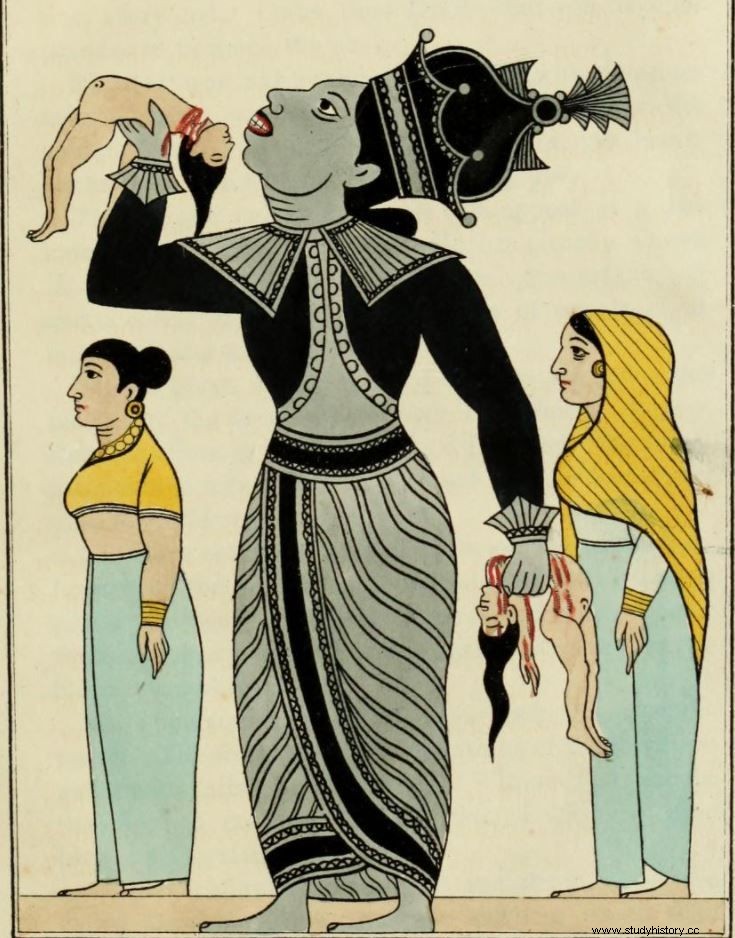
For anyone who is attracted to tall, dark and handsome strangers, Kalu Kumaraya will make you think twice. The name 'Kalu Kumaraya' means Black Prince and is known as the incubator of Sri Lanka. Legend has it that he was an old Sri Lankan prince, son and heir to the king. However, his greed for the throne led him to try to steal the throne from his father. When he failed, he took his own life. But as punishment for the act, he was denied access to the spiritual realm. Instead, he was cursed to spend his days on earth in the form of an incubator, feared and hated by all.
So now Kalu Kumaraya is a mix of a killer, stalker and seducer all rolled into a tall, dark and handsome spirit. According to legend, he lurks in the shadows and in the bathing areas and waits and hunts for young girls and women who walk alone. His demonic powers are so great that he is able to seduce the ignorant women to a point of ecstasy, where they ask him to kill them - something he really likes to commit.
Other legends claim that he is an attractive prince who despises young girls and pregnant women. In this version, he scares women into madness. When he met pregnant women, he put his hands on his stomach and caused an abortion. He is so feared by men that they hold rituals and offer to pose for him and protect their women.
The Horned Jackal
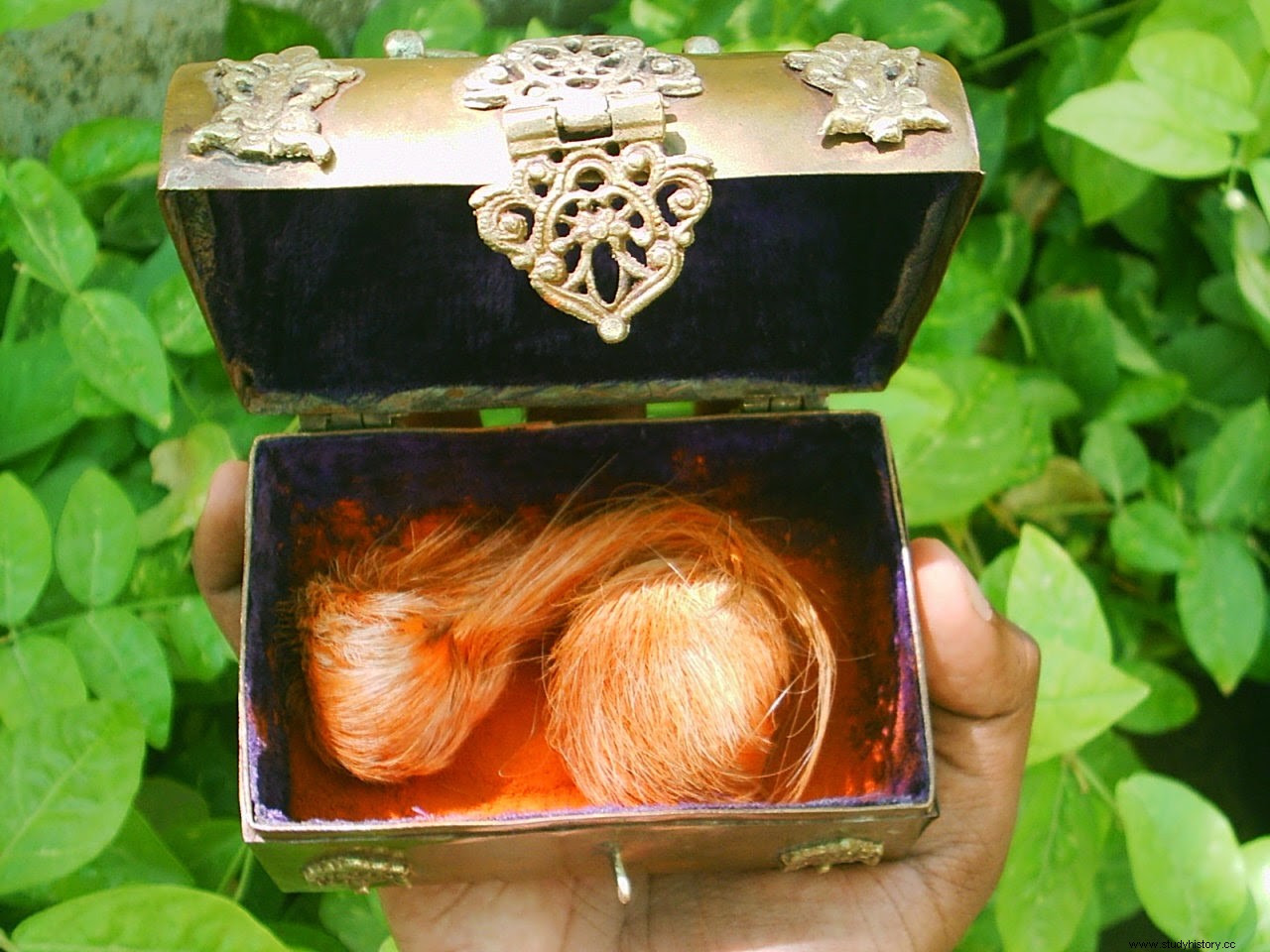
Here's a little known fact about some golden jackals - they are known to develop a small, horn-like protrusion on the back of the skull. This growth has hair on it. According to the Sinhalese, these horns are called a nari combination and are powerful, magical talismans that have many supernatural powers such as finding lost property, winning lawsuits and granting wishes. Others believe it has black magic and astrological powers.
It is not just the Sinhalese who believe in this theory. In Nepal, healers and witch doctors believe that this fable horn can win gambling and stay away from evil spirits. According to Nepalese, this horn only appears in the skull of the jackal that leads the herd, and it is formed when the herd howls together in chorus. Any hunter who is able to pull out the horn preserves the horn by placing it in a silver box filled with vermillion powder, which is believed to nourish the horn. They believe that the horn can even give the person the opportunity to see in the dark. In some areas, the horn is tied to the children's neck. In Bengal, India, people believe that placing the horn in a safe will increase the amount of money several times.
This belief has led to widespread hunting for the golden jackal. There are even websites that sell these horns and claim to have magical powers.
Maha Sona
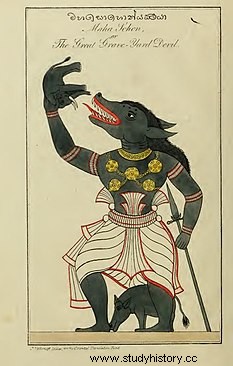
Maha Sona, according to folklore, is a spirit that haunts the afterlife. The name means 'largest demon' or 'demon in the cemetery' in Sinhala, and he is one of the most feared demons in Sri Lankan mythology.
Maha Sona is said to have been one of the ten legendary warriors of King Dutugemunu. His previous name was Ritigala Jayasena and was known for his formidable strength. However, when he insulted Gotaimbara, another of the ten warriors, in a drunken stupor, he was challenged to a duel, only to be defeated and beheaded. He was buried with a bear's head, since he was a bear hunter.
Since his funeral, he has roamed the earth with the head of a bear, owned black dogs and murdered everyone who crosses his path. He is described as a fearsome figure who stands 37 meters tall, with four eyes and four hands, with red skin. Armed with a pike in his left hand, he carries an elephant in his right hand, from which he drinks blood and rides a pig.
Maha Sona is the reason why many locals consider the appearance of a black dog as unfortunate or as having a leash to death. Many people think that burying a deceased person at noon calls him. It is claimed that he kills people by either inflicting a disease on them or by crushing their shoulders. For those who fall into the latter category, the mark of Maha Sona's hand will be imprinted on the body. Legend has it that he regularly appears in cemeteries in search of people, hence the name of the cemetery demon. Others claim that his haunting places are hills or boulders, with human corpses lying around him. The sight of Maha Sona scares people to the point that they are sick. Sinhalese believe he is responsible for causing cholera and dysentery.
The Devil's Bird
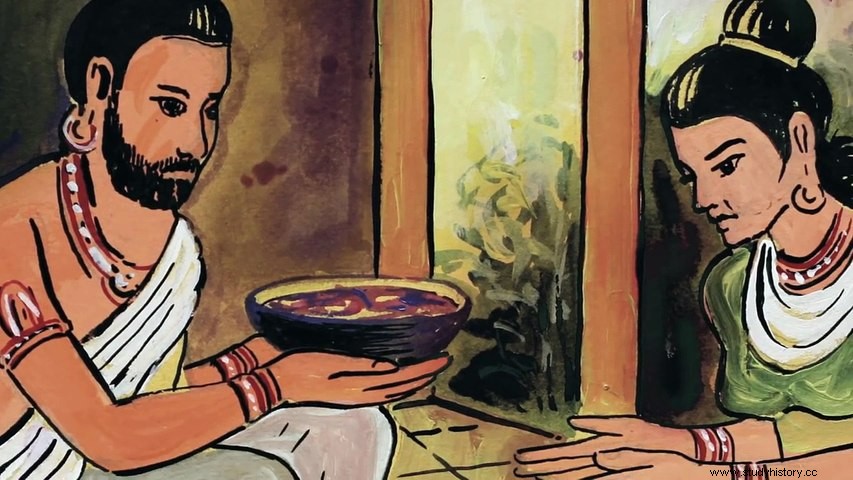
Sri Lanka's devil bird or ulama is said to haunt the country's forests. According to folklore, the cry of this bird is a sign of death, and all who are unlucky enough to hear it will die.
The story of the devil bird is as terrible as the cry itself. The bird's cry was actually born out of the actions of a jealous husband. Legend has it that a man who suspected that his wife was unfaithful to him, took revenge on her by murdering their boy when she was gone. When she arrived, the man served her a meal he had prepared with the baby's meat. The woman did not suspect anything until she found a finger of her baby in her plate. Driven to insanity by fear and sorrow, she ran screaming and wailing into the forest and was transformed into a bird. Legend has it that it is her heartbreaking cry that still echoes throughout the forest, frightening and bringing unfortunate happiness to all who hear it.
No one is sure what this devil bird looks like. Many claim to be the spot-bellied owl, but other potential birds include wood eagles, hawks, Ceylon honeybee grouse or highlands.
Maha Kola Sanni Yaka
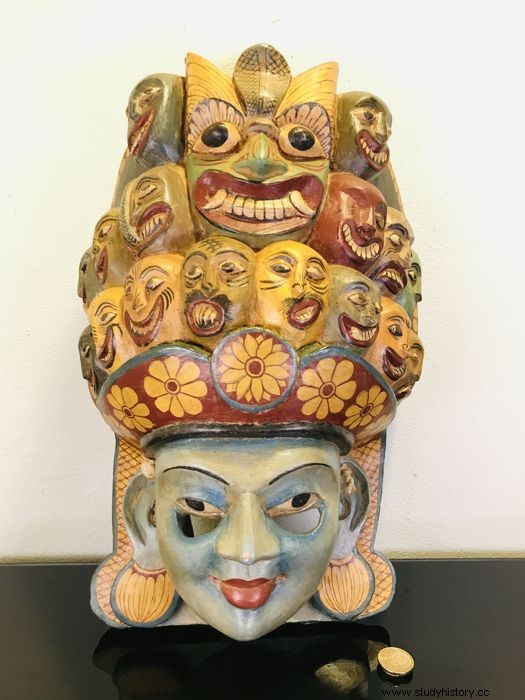
It is said that Maha Kola Sanni Yaka is the king of the demon, and rules over smaller demons that cause various diseases and ailments. According to Sri Lankan folklore, Maha Kola Sanni Yaka was born during the time of the Buddha. His mother was the queen. His father, who suspected that his wife was cheating on him, ordered her to be executed. The queen was pregnant at the time, and immediately after giving birth, she was executed. The story grows to be cruel here- the baby is said to have been fed with his mother's own flesh. The child grew up to be Maha Kola Sanni Yaka, who then created eighteen demons to kill people and create destruction among them as revenge against the father. It was the Buddha who convinced him to end the murder. Although killing humans is no longer on the demon's agenda, they still cause disease among the people, and keep many witch doctors in demand.
According to Sinhalese belief, if you have hearing problems, it is caused by Bihiriya Sanni Yaka. If you have stomach ailments, it is Amukku Sanni Yaka who is to blame. If anyone's gone crazy, Pissu Sanni Yaka is the culprit. In the same way, Sinhalese believe in demons for every disease.
Meaning in Anthropology
Although many of these myths and beliefs may seem peculiar to us, there is no denying that they play an important role in shaping a community's culture. In Sri Lanka, there are even places associated with legends such as Adam's Peak (where a footprint-shaped mark is attributed when either Buddha, Shiva or Adam set foot on earth), Ravana Falls (which is believed to be where Ravana took Sita after kidnapping her), Ritigala (the mountain of herbs that Hanuman took back to Rama when Lakshmana was wounded) and Adam's Bridge (narrow strip of land believed to be the bridge built by Rama's army to reach Sri Lanka). Many of us grew up with similar stories about legends and spirits. Ask any older person, and their childhood stories will always be filled with stories of spirits, folk tales and perhaps witch doctors singing some spells to drive away disease. During the time when Western medicine and technology were not yet available, these spirits were the ones who dominated the everyday lives of our ancestors. And so do they to this day.
